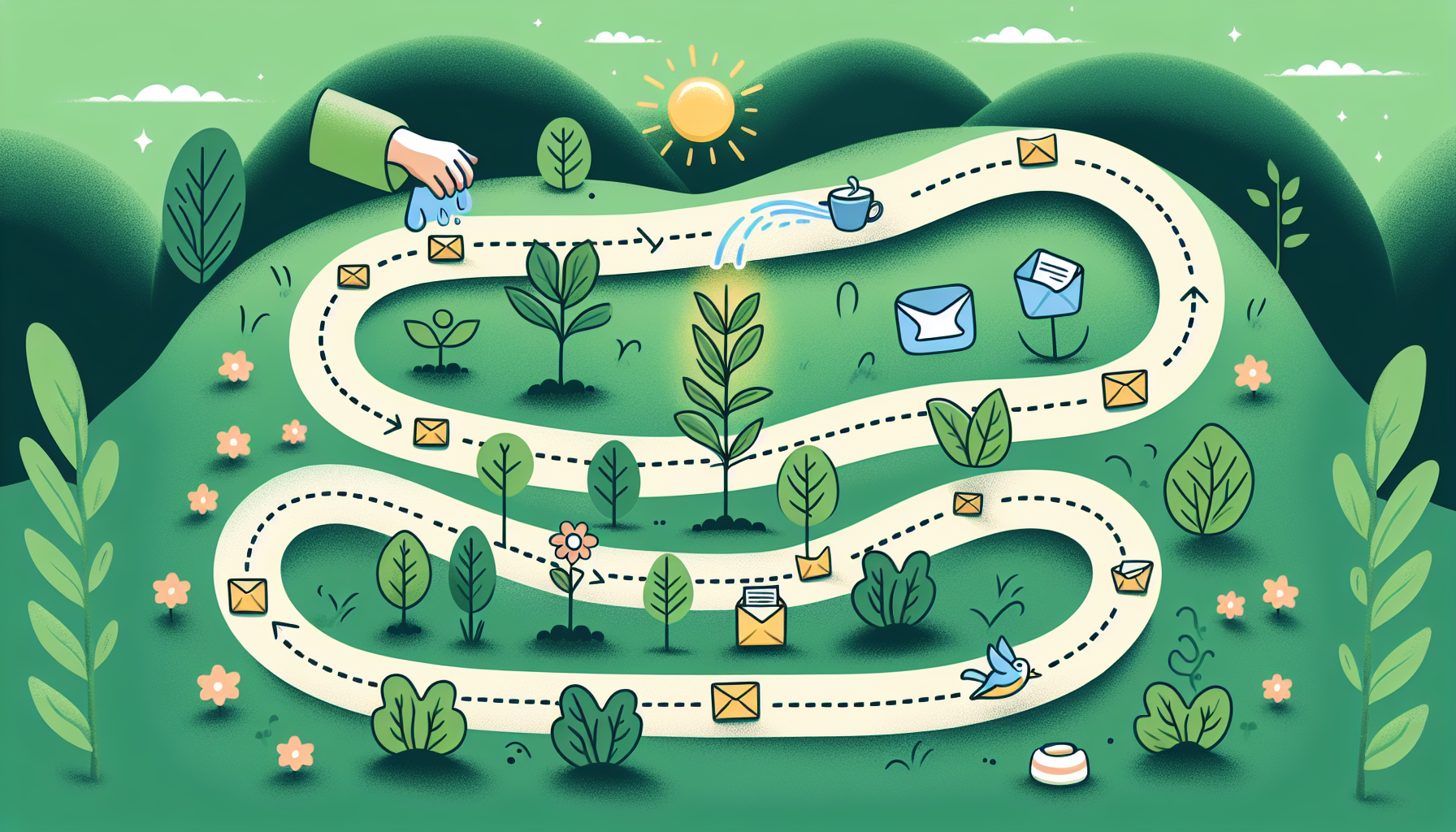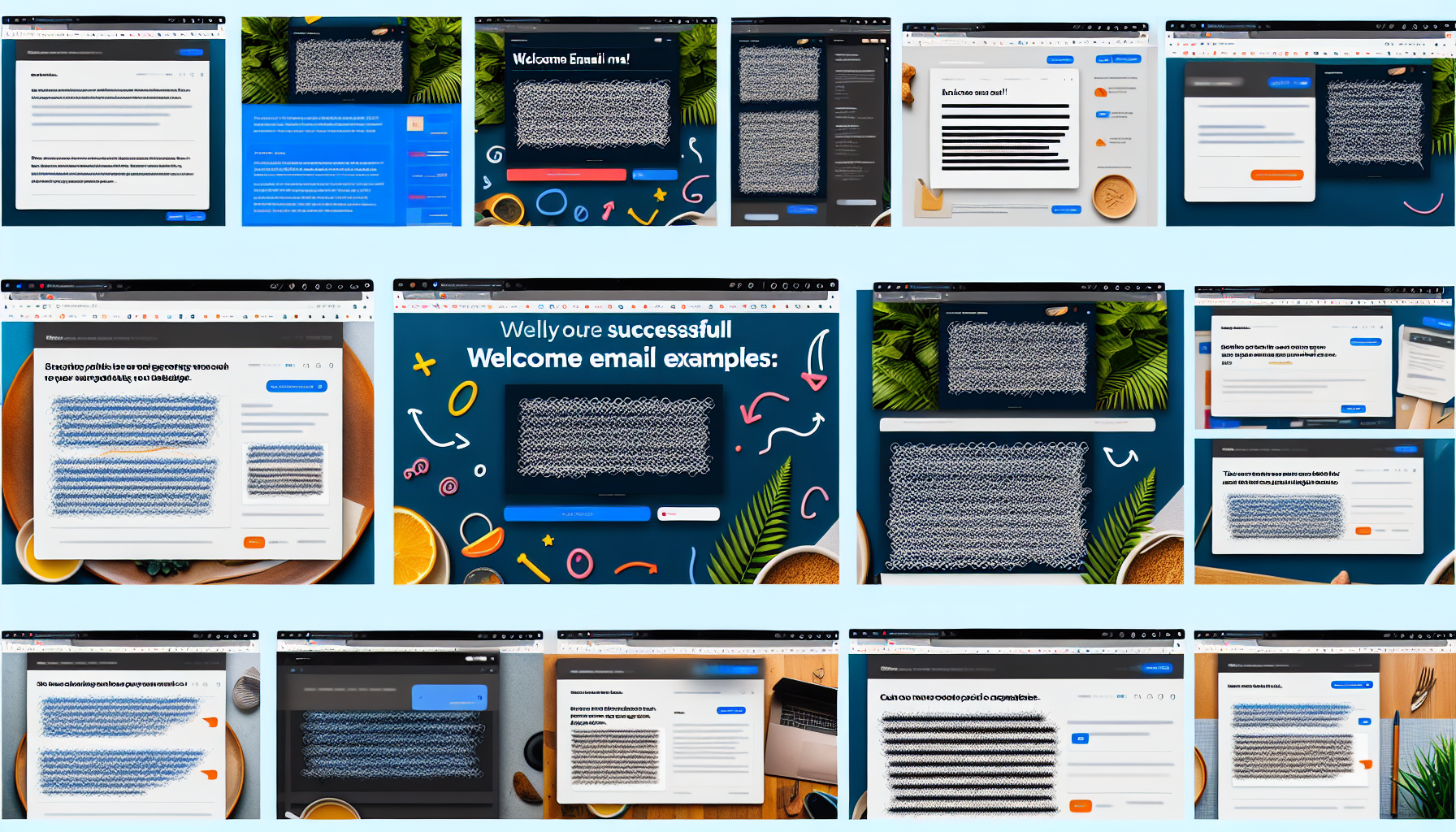
Uh-Oh
The page you are looking for doesn't exist or has been moved. Sorry about that!
Click the link below to head back to my homepage, or check out the links at the bottom right corner of this page to find what you're looking for.

Check Out The Blog

The Ultimate Guide to Crafting Welcome Emails That Win Clients for Accounting Firms
The Best Welcome Email Formula For Accounting Firms
Wondering how to capture your new subscribers’ attention and make a memorable first impression? A welcome email is the answer! It sets the tone for your future communications and is crucial in initiating a lasting relationship with your audience. Within seconds, it can determine whether a subscriber feels valued or overlooked. This article uncovers the art of crafting an effective welcome email, offering 20 prime examples and actionable tips to engage and captivate your new subscribers from the get-go.
Note: This article contains affiliate links. If you purchase using a link in this article, we may receive a small commission. Thank you for your support.
Key Takeaways
Welcome emails are critical for making a strong first first impression and can showcase an accounting firm’s expertise, with personalization and timely sending being key factors for success.
Subject lines serve as the first point of engagement, and personalizing them can significantly increase open rates; avoiding spam-trigger words and maintaining email list health are essential to avoid the spam folder.
Enhancing customer loyalty can be achieved through personalized greetings and segmentation, while a welcome email series provides an opportunity to nurture new subscribers, build relationships, and encourage further engagement over time.
Before you dig in, be sure to grab our free email template to consistently get more Google Reviews! This proven, plug-and-play email template has generated hundreds of Google Reviews for our clients, and something this good shouldn't be a secret. Grab your copy now!

Unlocking the Power of Welcome Emails for Accounting Firms

When a client first reaches out to your accounting firm, their experience is crucial. It sets the tone for future interactions and can leave a lasting impression. But with email becoming increasingly important in today’s digital world, creating that same welcoming feeling online may seem challenging. One aspect of your marketing strategy (welcome emails) holds significant potential to achieve this goal.
Often overlooked as just another routine email message, welcome emails serve as the virtual version of a warm handshake at an initial meeting. They express gratitude towards the new subscriber and create that vital positive first impression. Welcome emails are an excellent opportunity to showcase your accounting firm’s professionalism and expertise, and quickly establish trust with potential customers. The routinely neglected automated Welcome Emails possess more power than most realize.
Crafting Your Firm's Welcome Email: The Blueprint
Creating an effective welcome email for your firm requires a clear vision of the end goal and attention to detail. An onboarding welcome email should be send immediately after someone signs up for a call or opts into your email list. Think of it as delivering instant gratification that will create a hunger for more.
The subject line acts as the gateway to your email, and unlike many marketing or sales emails it should be straightforward, simple, and clearly state what the reader can expect. This helps set the tone for your new subscriber and clearly shows that you aren't going to spam them.
Aligning Your Email Communications With Your Brand
Think of your welcome emails as the first impression of your firm. They help subscribers understand who you are, how you communicate, your tone, energy, character traits, look, and feel, and all of this comes together to make your brand recognizable in the industry. To be frank, all of your emails should align with your brand identity and create a consistent experience for subscribers. This can be achieved by using a well-designed welcome email template that incorporates all aspects of your brand - logos, colours, and imagery.
A welcome email is more than just an initial greeting. It serves as a reflection of who you are as a firm. By using language and tone that reflect the values important to your accounting business, you can effectively showcase what drives your company’s ethos.
To ensure this alignment with your communication:
Create comprehensive guidelines for your firms brand voice and identity
Craft a “brand story” that is used consistently through your marketing materials;
Include specific examples of how the firm communicates via email; and
Create a content approvals process so one person is in control of approving marketing emails and ensuring brand voice guidelines are followed.
By following these guidelines, you pave the way for consistency across all brand communications. Remember, consistency is an important component to building trust, and by maintaining a consistent brand voice, you're on the path to building trust before words are spoken.
Organizing Your Email List

Personalization can make your clients feel valued and appreciated from the very beginning of their relationship with your firm. The key to successful personalization isn't just about throwing your readers name in the email–it's about understanding your customers’ needs and adapting your content accordingly.
Segmentation is a powerful tool that helps you organize your audience based on interests, behaviour or demographics for targeted personalized messaging that resonates with each group. It's as simple as asking the subscriber what they want, and giving them more of that and less of other stuff.
Segmenting Your Audience for Tailored Content
By splitting your email subscribers into various groups based on their interests or actions, you can tailor content to meet their specific needs and preferences.This not only increases the relevance of your emails but also enhances the overall experience for clients.
Now, if that sounds too complicated, let's make it easier. Start by identifying your existing clients in your email list and tagging them–they already signed with your firm and don't need the same marketing emails you'll send non-clients. Then create an automation that tags all new customers so you can keep that segment up to date.
There are lots of ways to segment your audience, from filling out forms, clicking links in your emails, ann the way to what they purchase and whether they even open your emails. Once you've identified the most important segments for your email list, you can create personalized content for each group using. This level of personalization not only boosts relevancy but also helps strengthen relationships between clients and business owners.
The Welcome Series: Nurturing Subscribers Over Time

Growing your email list is a crucial aspect of any firm's marketing efforts. The goal is to attract ideal clients and guide them through your company’s services, unique selling proposition, and establish a lasting connection beyond the initial email. Setting up a series of emails that automatically send after your welcome email can effectively nurture subscribers and lead them through your indoctrination process.
Creating an effective welcome series requires careful planning and execution. Key elements include timing, subject lines, personalized messages, and content all play important roles in its success.
By continuously nurturing subscribers, you can develop stronger relationships with them while also increasing engagement levels which ultimately leads to more clients, referrals, and renewals for your firm.
Mapping Out Your Welcome Email Campaign
Creating an effective welcome email and it's subsequent emails isn't complicated. The first stop on this journey is the initial welcome email sent immediately after subscription, which sets the tone for future interactions.
When crafting your welcome email, there are a few important components to include.
Attention-grabbing subject line: A straightforward subject line to encourage recipients to open the message.
Personalization: Start by addressing subscribers with a friendly greeting followed by a brief introduction about your firm. Use the subscribers' names throughout the email using Merge Tags whenever possible.
Description of services offered: Clearly outline all the accounting and financial services your firm provides to give readers an understanding of who you are, what you do, and how you can help.
Customer support contact information and resources available: At the bottom of the email, it's great practice to include relevant contact details as well as your booking link or contact form.
By incorporating these elements into your welcome email, you can create an engaging experience for subscribers while providing helpful customer service contact information right from their very first interaction with your firm. This way, you'll leave a good impression and the reader will know they have access to customer service if needed.
Building a Robust Email Marketing Strategy
Developing an effective email marketing strategy requires understanding your audience and competitors, and making data-driven decisions to refine your campaigns and achieve successful outcomes, whatever that means for your firm. It's not a perfect science; marketing is a game of trying, testing and optimizing. Ultimately, the goal is to build stronger relationships and trust with your audience.
To successfully implement a data-driven decision-making approach in email marketing, there are several important steps to follow.
Niche your firm to attract ideal clients and stand out from the competition;
Tailor the type of accounting content according to your specific audience;
Encourage engagement through interactive elements and include a call-to-action in each email;
Use automation tools for more efficient management of your campaigns; and
Leverage customer information and segmentation techniques to create targeted messaging.
You can deliver highly relevant messages that resonate with your audience while also achieving business objectives effectively with these simple steps. The goal should be making better connections at lower costs by using opt-in newsletters as well as tracking metrics such as open rates & click-throughs to grow your audience and generate more clients. One thing’s apparent: accountants love data. Now you must learn how to leverage your marketing data to attract and keep more clients!
Leveraging Data-Driven Decisions in Campaigns
As an accountant, you know the power that data and analytics hold. This also applies to your email marketing since you can leverage insights into your subscribers’ behaviours and preferences, and make informed decisions about content and targeting. By leveraging these data-driven decisions in your campaigns, you can improve the effectiveness of your emails and drive more conversions.
Crafting the Perfect Welcome Message
Crafting an effective welcome message involves providing valuable resources, setting expectations, and showcasing your firm’s expertise. A well-crafted welcome message can establish the tone for the relationship and manage expectations about communications and further engagements with your brand. Try adding a personal touch to your welcome message by including the users name within the content which creates a sense of familiarity and warmth. Feature your company’s expertise within the content to showcase trustworthiness and credibility.
Incorporating useful resources in your welcome emails not only adds value to clients but also showcases the depth of knowledge within your organization. These helpful resources may consist of downloadable templates, checklists, guides or important dates.
The Role of Subject Lines in Welcome Messages

The subject line in an email is the first thing that catches a client’s attention. It serves as the headline, title or facade of the content and sets its tone. This makes it crucial to determine whether clients will open your email or not, especially for accounting firms where professionalism and credibility are key factors.
Creating engaging email subject lines requires more than just clever wording. Personalization by including recipient names, relevance to the field of accounting, brevity with an element of intrigue and clear calls to action can all contribute to increasing client engagement. Sending welcome emails immediately to new users can also create a positive initial impression on clients, which may lead to higher levels of interaction.
Crafting a Catchy Welcome Email Subject Line
Crafting compelling subject lines is crucial in boosting the open rates of your email. It serves as a hook to capture the attention of readers and encourage them to read on. A well-crafted subject line not only captivates but also provides a sneak peek into what the email entails, ensuring clear expectations.
To avoid having your email marked as spam, it is best to steer away from specific phrases and words like ‘acceptance’, ‘accordingly’, ‘avoid’, ‘chance’ or even including a discount code. These terms may trigger spam filters and hinder your message from reaching its intended recipient.
Personalizing subject lines can greatly enhance open rates as well. On average, personalized subjects have shown an increase in opening by 29.3% compared to non-personalized ones.
Avoiding the Spam Folder: Best Practices
Email doesn't work if it ends up in spam, and that includes your welcome emails. There is a risk of your messages being mistakenly flagged as spam and not reaching their intended audience. To prevent this from happening, it is important to adhere to some best practices.
Some recommended approaches to avoid being labeled as spam include using a reputable email service provider, personalizing emails, and avoiding the use of words or phrases that may trigger anti-spam measures. And regularly managing your email list by removing any addresses that consistently bounce back to maintain reasonable bounce rates and ultimately improve open rates.
The Importance of Giving Helpful Resources in Your Welcome Emails
Welcome emails are a perfect place to build feelings of reciprocity from your audience by including "surprise and delight" elements like valuable resources. This practice also helps establish you as a thought leader in the accounting industry while building trust.
The type of resources that can be included in welcome emails may vary depending on what is relevant to each client’s needs and interests. Some examples could include popular blog posts, downloadable guides, templates, checklists, updates on policies or tax deadline information. The important factor is ensuring that these resources add value. Sprinkling in free resources that aren't perceived as valuable to the reader won't do you any good.
Adding curated resources to welcome emails demonstrates how invested you are in their success, which ultimately positions your business as more than just another online store or service provider - but rather an invaluable partner who truly cares about their financial well-being.
Encouraging Further Engagement Through Email Content
The success of your firm’s emails relies heavily on the value of the content provided. By balancing informative and promotional material, you can effectively engage with your readers while promoting your services. This not only maintains a level of interest in the email but also helps guide clients toward desired actions. Think "soft-selling."
We recommend a combination of 80% informational emails to 20% promotional emails. This ensures that value is consistently being delivered to recipients along with information about services. To make the promotional emails more appealing, personalize them and offer relevant recommendations based on individual preferences (see segmentation).
Balancing Informational and Promotional Content
Have you ever subscribed to something and then were immediately bombarded by sales emails? Not fun. Striking the right balance between informational and promotional content is key to keeping your readers happy and engaged. That doesn't mean you shouldn't sell or send promotional emails, it just means that leading with value leaves people wanting more. Informational content educates your clients and helps them understand your services better. On the other hand, promotional content promotes your services and guides your clients towards taking a desired action. You need both.
To balance these two types of content effectively, you need to understand your client’s preferences and behaviours. You can gather this information through subscription forms or by analyzing your clients’ interactions with your firm. Once you have this information, you can create a content strategy that balances both types of content, ensuring that your emails provide value to your clients and guide them toward the desired action.
Streamlining the Welcome Email Process with Automation
Automating the welcome email process can result in time-saving and maintain consistency in messaging. Automation tools can help you manage your welcome email campaigns more efficiently, allowing you to focus on other important aspects of your business. By automating your welcome emails, you can ensure that your new contacts receive timely and personalized welcome messages, creating professional and reliable communication right from the start.
When choosing an email automation platform, you should consider features like the ability to schedule emails ahead of time, integration with accounting practice management software, and positive reviews from other accounting firms. These features can help you manage your welcome email campaigns more efficiently and ensure a consistent brand experience.
Selecting the Right Email Automation Platform
When it comes to effectively managing welcome email campaigns, selecting the appropriate email automation platform is crucial. The right platform can automate your emails, maintain consistent messaging, help you avoid deliverability issues, and save you valuable time. Features like scheduled sending of emails, triggers, segmentation, and personalization capabilities are be included in any good platform.
A few of our favourite email service providers for accounting firms are:
Another benefit of using an effective email automation system instead of using a personal email provider like Google Workspace or Microsoft Outlook is maintaining a cohesive brand experience. It's much easier to stick to your brand identity with email service providers because you can build custom email templates that maintain consistency. This ensures that all outgoing messages accurately reflect the personality associated with your business’s image or reputation, which ultimately leads to building trust among clients while boosting the overall impact of any welcome mail sent out.
Maintaining Personal Touch in Email Communications
Welcome email templates are great, but most people plug-and-play without adding any personal touches. This leaves readers feeling disconnected and can present a challenge for accounting firms who want to build customer loyalty. By humanizing your automated emails, you can maintain a personal connection with your clients and foster genuine connections.
Strategies for Humanizing Automated Emails
The first place we recommend accounting firms go is into their automated invoicing, booking and firm management emails. The automated transactional emails from most providers are terrible–a simple step is adjusting the language in your automated invoicing and booking emails to match your brand voice. Whenever possible, add personalization to these emails by incorporating the readers name using merge tags. It's all about finding the right balance of human and information in transactional emails. Creating loyal customers starts with your well crafted welcome email and extends into all communications between your firm and clients.
Learn From The Best: How To Find Examples of Effective Welcome Emails

At 90-Day Campaigns, we like to call it R&D (Rip-Off And Duplicate). Borrowing insights from successful use cases can be a great approach for improving your own work. When it comes to welcome emails, there are tons examples of accounting firms effectively engaging their newest subscribers. These emails not only leave a positive initial impression, but also demonstrate the firm’s expertise, foster strong connections, and increase customer retention.
Effective welcome emails usually share these similar elements:
Succinct subject line
Intelligently written
Welcoming tone
Sets expectations
Personalized greeting
To see how other firms are using these elements, we recommend doing some research! Subscribe to a few other firms to see how they welcome their audience and set expectations. You aren't copying–you're there to learn and compare welcome email tactics.
It's Time To Craft Your Welcome Email
To sum up, welcome emails are crucial for first impressions, and help you engage prospective customers and turn them loyal customers. From showcasing your accounting firm’s expertise to establishing strong relationships, standout welcome emails can do it all.
With welcome emails that reflect your brand image, use attention-grabbing subject lines, personalize greetings, and balance informative and promotional content, you can kickstart a long and mutually beneficial relationship. Automation tools simplify the process of sending out these emails while maintaining consistency in style, but it is important to inject a human touch into them and not just rely on welcome email templates. By following the tips laid out in this article, you'll enhance your email marketing efforts and attract new customers more efficiently.
Frequently Asked Questions
How do you write a welcome email?
When writing a welcome email, start with a warm subject line and address the subscriber by name. Express appreciation and keep the email concise while including social proof to build trust.
Remember to email immediately, thank your recipient and confirm their sign-up, then explain what they can expect in a short and sweet manner.
How do you write a good welcome email sequence?
An effective welcome email series should consist of a series of emails that build upon each other to provide information about your firm, services, and what sets you apart from the rest. Use precise subject lines, always use the subscriber’s name, and deliver high-quality content. Don't forget to include a strong call to action. Additionally, it is important to include an option for unsubscribing. Your initial email should act as a welcoming message that greets new subscribers. Each subsequent email should deliver value and build trust with the reader.
What do you call a welcome email?
A welcome email is the first communication you send to a new subscriber or a new customer, creating the initial impression for a lasting relationship. It sets the tone for future emails and interactions and establishes a positive connection with the recipient.
What are some effective ways to craft a compelling subject line?
Create a captivating subject line is about making it personalized, curiosity building, and concise. You can use the preview text area to incorporate a clear call to action and make it attention-grabbing to encourage the recipient to open your email.
How can personalization enhance customer loyalty?
Personalization has the potential to increase loyalty with your customers by creating a sense of connection, increasing the relevance of the content sent, ultimately fostering a strong and positive relationship.
Explore
Free Resources
90-Day Campaigns Inc.
430 Hazeldean Road, Suite #6, Unit #17
Kanata, Ontario, Canada, K2L 1T9
Toll-Free: 1-866-977-3480
90-Day Campaigns Inc. is located on the traditional unceded, unsurrendered territory of the Anishinaabe Algonquin People.
© 90-Day Campaigns Inc., 2024. All rights reserved.



